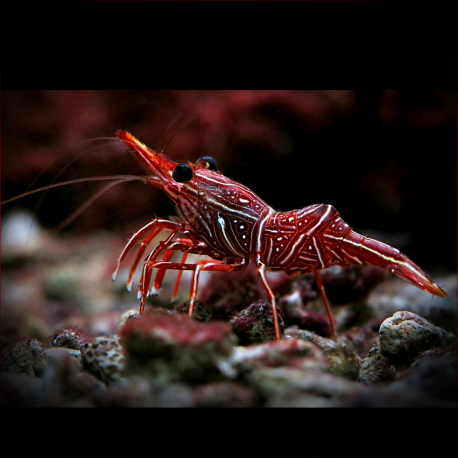More info
Datasheet
| Maximum Size | 5.1cm / 2.01inches |
| Reef Compatible | With Caution |
| Temperament | Peaceful |
| Care Description | Easy |
| Specific Gravity | 1.023-1.025 |
| Carbonate Hardness | 8-12 |
| pH | 8.1-8.4 |
General Description
The Camel Shrimp, scientifically known as Rhynchocinetes durbanensis, is also referred to as the Hinge-beak Shrimp, Dancing Shrimp, or Candy Shrimp. It is characterized by a moveable rostrum (beak) that typically points upwards. Sporting a striking pattern of red and white stripes on its body, this shrimp displays variability in its coloration. Males of this species possess larger chelipeds (claws) compared to females.
Aquarium Suitability and Demands
The Camel Shrimp is considered easy to care for, making it an excellent choice for marine invertebrate enthusiasts, including beginners. Its peaceful temperament allows it to coexist with other tank mates, preferably of similar species, in an aquarium setting.
Care and Hardiness
This shrimp prefers to dwell in rock crevices, under overhangs, or amidst coral rubble, necessitating adequate hiding spots, especially during molting. While generally tolerant of other shrimp species, the Camel Shrimp may exhibit aggression towards colonial anemones, disc anemones, and soft leather corals, but tends to leave bubble coral and stinging anemones undisturbed.
Reef Suitability
The Camel Shrimp is deemed reef-compatible with caution, as it may occasionally nip at certain corals. Care should be exercised when introducing this shrimp to a reef tank to prevent any potential coral damage.
Aquarium Setup
When setting up an aquarium for the Camel Shrimp, it's crucial to provide ample rock formations and hiding spaces to mimic its natural habitat. Maintaining stable water conditions with a pH level ranging from 8.1 to 8.4, a specific gravity of 1.023-1.025, and a carbonate hardness (KH) between 8-12 is essential for its well-being. Additionally, supplementing the tank with calcium, magnesium, iodine, and trace elements will help support the shrimp's health.
Behaviour
This species of shrimp exhibits peaceful behavior towards tank mates, making it a suitable addition to community aquariums. Its tendency to congregate with its own kind underscores its social nature within a captive environment.
Feeding and Diet
As an omnivore, the Camel Shrimp readily accepts a varied diet, including brine shrimp, frozen or freeze-dried plankton, and flaked foods. Providing a balanced diet rich in nutrients will promote the shrimp's overall health and vitality.
Dimorphism
Male Camel Shrimp typically feature larger chelipeds (claws) compared to females, allowing for easy visual sex differentiation within the species.
Habitat and Distribution
In the wild, Camel Shrimp can be found congregating in rock crevices, under overhangs, and coral rubble in the oceanic habitats they occupy. Their distribution spans across select regions, showcasing their adaptability to various marine environments.

